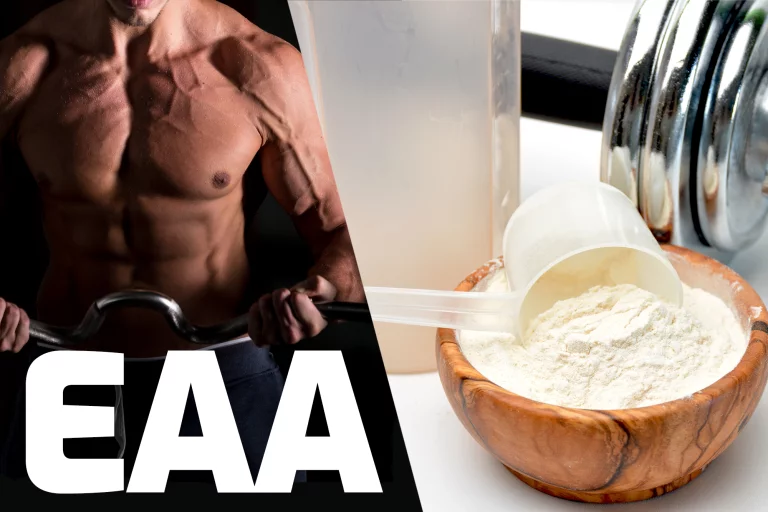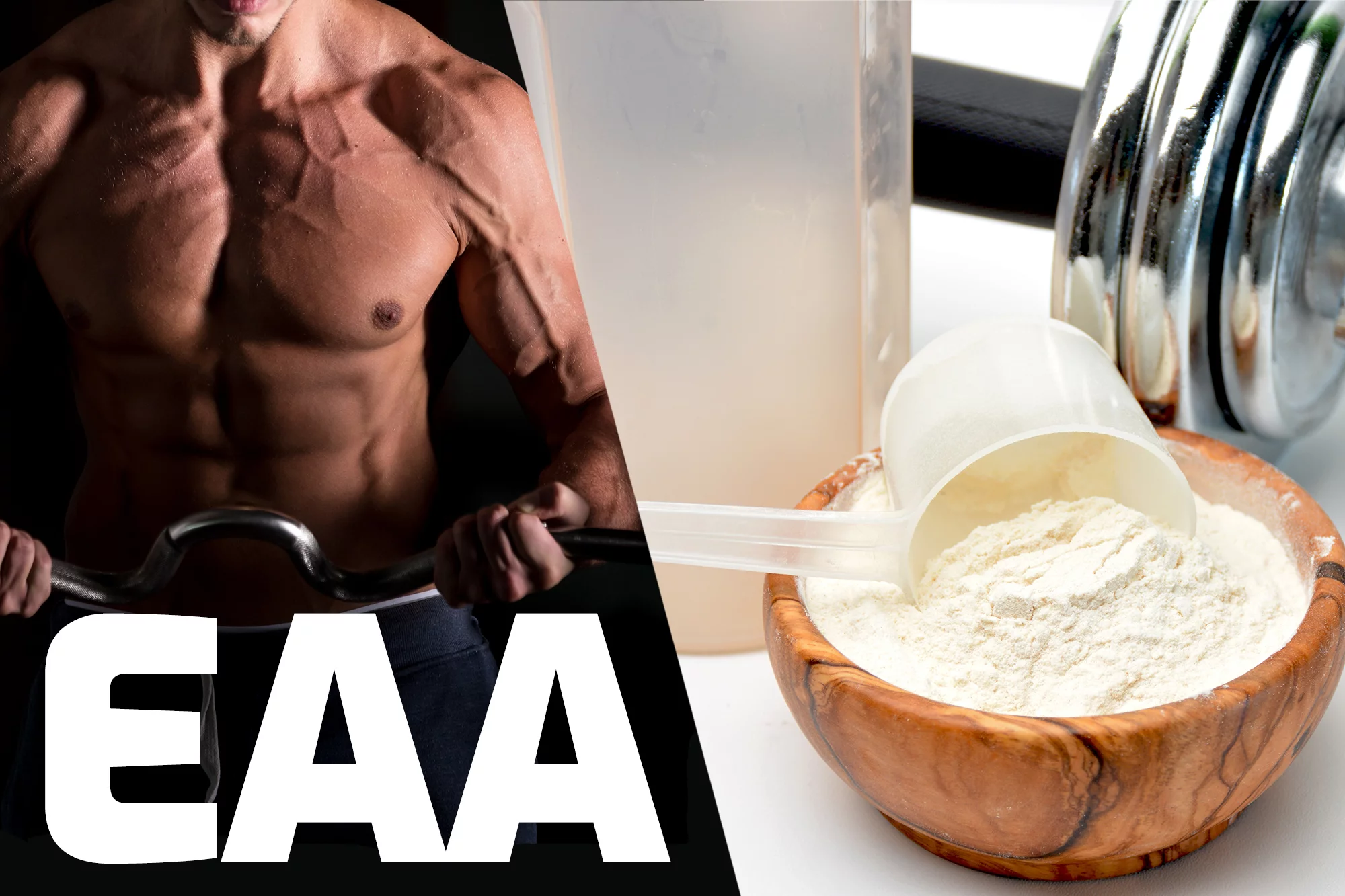Essential amino acids - EAA or BCAA?

Amino acids are the basic building blocks of proteins. These are organic compounds linked to each other via a peptide bond. Each amino acid must contain at least one amino group (-NH2) and at the same time at least one carboxyl group (-COOH). They are the basic building block of proteins.
Structure
The individual amino acids (basic building blocks, monomers) are combined to form larger units. When 2 to 100 amino acids are merged, peptides are created. If 100 or more amino acids combine, we're talking about proteins. The biological properties of proteins are given by the type of amino acids, their order and their spatial relationships. Amino acids represent 75% of net body weight, make up 95% of muscle (including cardiac) and 100% of hormones, neurotransmitters and neuropeptides [1].
Occurrence
There are more than 700 different amino acids in the wild [2]. However, in living organisms or in their proteins, only 22 of them, so-called proteinogenic (biogenic) amino acids, occur. There are 20 amino acids in the human body, 9 of which are essential, which means that the body cannot make them on its own and must be taken either from the diet or from supplements. It should be emphasized that the biological significance of proteinogenic amino acids is directly proportional to the ratio of the least numerous of them. Simply put, if at least one amino acid is missing in the body, the remaining 19 are practically unusable [3].
Types
NON-ESSENTIAL AMINO ACIDS - alanine, arginine, asparagine, cysteine, glutamine, glycine, aspartic acid, glutamic acid, proline, serine, tyrosine, selenocysteine, pyrrolidine
ESSENTIAL AMINO ACIDS – phenylalanine, histidine, isoleucine, leucine, lysine, methionine, threonine, tryptophan, valine
Essential amino acids in detail
PHENYLALANINE– Helps the body use other amino acids, proteins and enzymes. It is a precursor of tyrosine and at the same time neurotransmitters dopamine, adrenaline and noradrenaline. Phenylalanine deficiency in humans can be manifested by confusion, emotional agitation, depression, memory impairment, behavioural changes, decreased libido, or cataracts. A congenital disorder of phenylalanine metabolism is called phenylketonuria and, if left untreated, can lead to severe mental retardation. The basis of therapy is a lifelong diet low in phenylalanine [4].
HISTIDINE – In the human body, it acts as a precursor for the production of histamine and carnosine. Histamine is a signalling molecule that triggers an inflammatory response and serves as a neurotransmitter. Carnosine is principally a buffer (a substance that maintains a stable pH inside cells). It also plays a role in regulating ion entry into cells, muscle contraction, protection against oxygen radicals and unwanted glycation in cells [5]. Histidine deficiency can lead to anaemia in humans.
ISOLEUCINE – It helps to restore muscle fibres after strenuous physical activity, regulates blood sugar levels. Its deficiency is manifested, for example, by a headache [6].
LEUCINE– Together with isoleucine and valine, they are among the branched chain amino acids (BCAA), that are highly effective in stimulating protein synthesis in striated muscles [7]. Compared to other amino acids, its effect is disproportionately more noticeable. One of the best explored routes is the mTOR (Mechanic Target of Rapamycin) route. Decreased leucine levels signal mTOR protein deficiency, which blocks the formation of new proteins. Of course, it applies vice versa, too - elevated leucine levels signal mTOR that there is enough protein in the body from the diet and turn on overall protein synthesis. Leucine deficiency is manifested by skin problems, hair loss and fatigue.
LYSINE - Plays a major role in calcium absorption, muscle building, recovery from surgery or injury, and the production of body hormones, enzymes, and antibodies. It has also been shown to play a substantial role in people with anaemia, as it affects the total iron intake and consequent concentration of ferritin (iron-containing storage protein) in the blood plasma [8].
METHIONINE – It is a source of sulphur, so it prevents problems with the skin and its derivatives, supports hair growth. By increasing the production of lecithin in the liver, it helps lower cholesterol. At the same time, it reduces the fat content in the kidneys and liver. It regulates the production of ammonia, prevents irritation of the bladder by reducing the amount of ammonia in the urine. It is a natural chelating agent for heavy metals [9].
THREONINE– It is important for healthy skin and teeth, as it is part of tooth enamel, collagen and elastin. It helps in fat metabolism and may be beneficial for people with indigestion, anxiety and mild depression [7].
TRYPTOPHAN – It is a precursor in the biosynthesis of serotonin, melatonin and niacin (vitamin B3). It has been used in the past as an analgesic [10].
VALINE– It is vital for mental health, muscle coordination and emotional peace. It affects muscle growth, tissue regeneration and energy preservation. Its deficiency can cause insomnia and reduced mental function [11].
Sources of essential amino acids [7]
PHENYLALANINE - dairy products, meat, soy, fish, beans, nuts
HISTIDINE - meat, fish, poultry, nuts, seeds
ISOLEUCINE - meat, fish, poultry, eggs, cheese, lentils, nuts, seeds
LEUCINE - dairy products, soy, legumes
LYSIN - meat, eggs, soy, black beans, quinoa, pumpkin seeds
METHIONINE - eggs, nuts, seeds
THREONINE - cottage cheese, wheat germ
TRYPTOPHAN - wheat germ, cottage cheese, chicken, turkey
VALINE - soy, cheese, peanuts, mushrooms, vegetables
BCAA vs. EAA
As mentioned above, if one of the amino acids is insufficiently present in the human body, the other amino acids cannot perform their functions adequately. In this respect, the current trend of highlighting the role of BCAAs over EAAs is more than undesirable. The body needs ALL amino acids of equal importance. Preference for those with a higher BCAA content in nutritional supplements may not, in principle, be detrimental, but only if you ensure sufficient intake of other amino acids. Simply put, if you can, prefer EAA supplementation to BCAAs.
EAAs are the source of all essential amino acids, BCAAs contain only 3 essential amino acids (L-leucine, L-isoleucine, L-valine).
SOURCES:
OLIVIERA, R. The Essentials – Part One. UC Davis Integrative Medicine. [online]. 2016. Available at: https://ucdintegrativemedicine.com/2016/02/the-essentials-part-one/#gs.q8isp4
COLLECTIVE OF AUTHORS. Amino acids, peptides and proteins. University of Chemical Technology [online]. 2014. Available at: https://web.vscht.cz/~dolezala/CHPP/4%20Amino acids.pdf
KIRSCHMANN, J. Nutrition Almanac. McGraw-Hill Education, 2007, 371 p., ISBN 00-714-3658-8.
COLLECTIVE OF AUTHORS. Phenylalanine. National Center for Biotechnology Information. PubChem Database [online]. Available at: https://pubchem.ncbi.nlm.nih.gov/compound/L-phenylalanine
ARTIOLI, G., SALE, C. et al. Carnosine in health and disease. European Journal of Sport Science [online]. 2019, nr. 19, p. 30-39. ISSN 1746-1391. DOI: https://doi.org/10.1080/17461391.2018.1444096. Available at: https://www.tandfonline.com/doi/abs/10.1080/17461391.2018.1444096?journalCode=tejs20
NISHIMURA, J., MASAKI, T. et al. Isoleucine prevents the accumulation of tissue triglycerides and upregulates the expression of PPARalpha and uncoupling protein in diet-induced obese mice. The Journal of Nutrition [online]. 2010, vol. 3, nr. 140, p. 496-500. Available at: https://academic.oup.com/jn/article/140/3/496/4600398
BERRY, J. What to know about essential amino acids [online]. 2019. Available at: https://www.medicalnewstoday.com/articles/324229.php
RUSHTON, D. Nutrition factors and hair loss. Clinical and Experimental Dermatology [online]. 2002, vol. 27, nr. 5, p. 396-404. Available at: https://onlinelibrary.wiley.com/doi/abs/10.1046/j.1365 2230.2002.01076.x?sid=nlm%3Apubmed
FENG, R., NIU, C. et al. Histidine supplementation improves insulin resistance through suppressed inflammation in obese women with the metabolic syndrome: a randomised controlled trial. Diabetology [online]. 2013, vol. 56, nr. 5, p. 985-994. Available at: https://link.springer.com/article/10.1007%2Fs00125-013-2839-7
SZOLCSÁNYI, P. From Aspirin to Viagra. Faculty of Chemical Technology of STU Bratislava [online]. Available at: http://www.chtf.stuba.sk/~szolcsanyi/education/files/Od%20Aspirinu%20k%20Viagre.pdf
COLLECTIVE OF AUTHORS. Methionine. National Center for Biotechnology Information. PubChem Database [online]. Available at: https://pubchem.ncbi.nlm.nih.gov/compound/L-methionine




